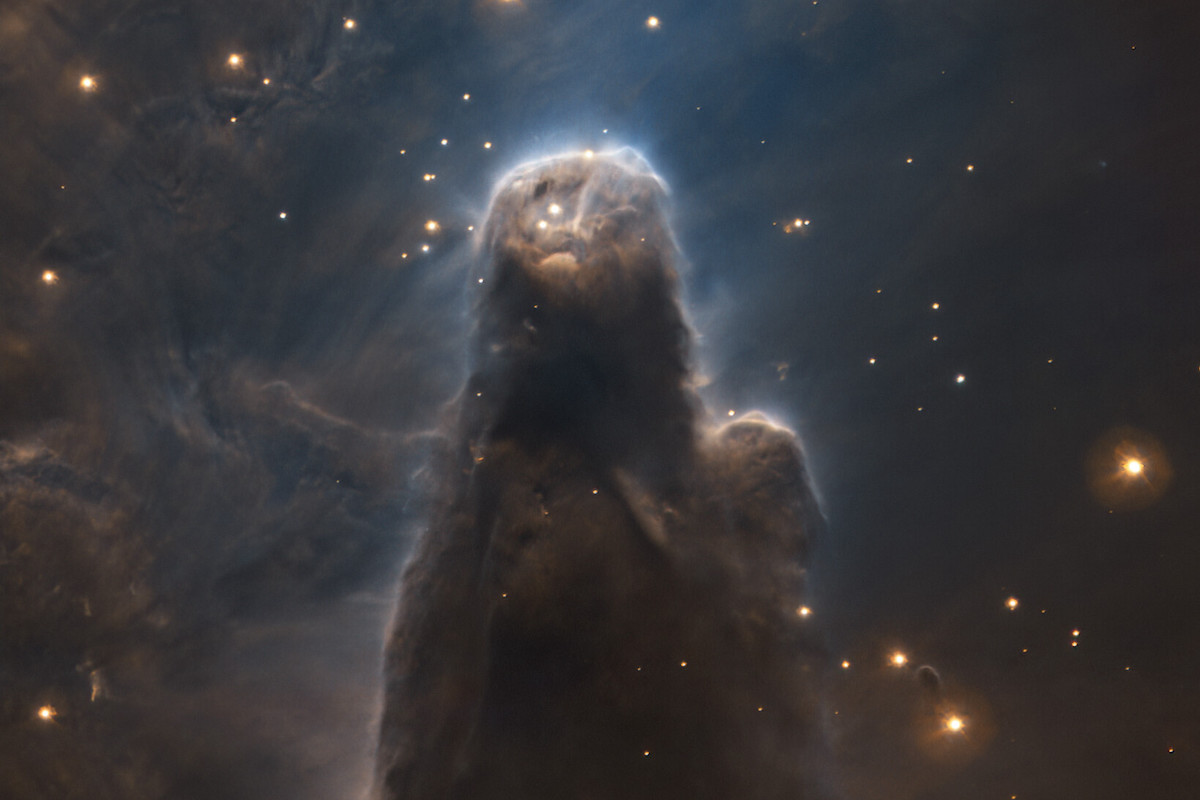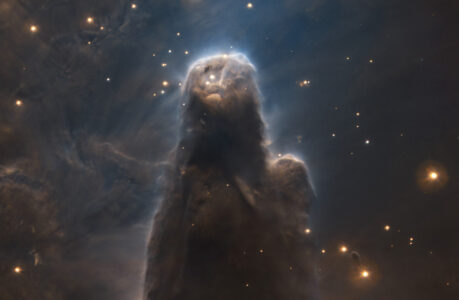The Cone Nebula, also known as NGC 2264, is a remarkable astronomical object that has fascinated astronomers and stargazers alike for decades. This interstellar cloud of gas and dust is located in the constellation Monoceros, about 2,700 light-years away from Earth. The nebula is named for its distinctive cone shape, which is created by a dark, opaque cloud of cold molecular gas that obscures the light emitted by the stars behind it.
The Cone Nebula is part of a much larger star-forming region known as the Christmas Tree Cluster. This cluster is a young and active region where new stars are being born. The bright stars at the top of the Christmas Tree Cluster, which illuminate the Cone Nebula, are hot, young stars that emit intense ultraviolet radiation. This radiation ionizes the gas in the nebula, causing it to glow and produce stunning colors that range from deep red to vibrant blue.
One of the most intriguing aspects of the Cone Nebula is the dark, dense cloud of gas and dust that creates its distinctive shape. This cloud is so dense that it blocks out much of the light emitted by the stars behind it, making it difficult for astronomers to study them. However, recent observations using the Spitzer Space Telescope have revealed that there may be a cluster of young, low-mass stars hidden within the cloud. These stars are not yet visible in optical light, but they emit infrared radiation that can be detected by Spitzer.
The Cone Nebula also contains a fascinating structure known as the “Hubble’s Variable Nebula“. This structure is a reflection nebula, which means that it reflects the light from a nearby star. What makes it special is that it is not a static structure, but rather it changes shape and brightness over time. The cause of these changes is not yet fully understood, but it is thought to be related to the variable nature of the star that illuminates it.
Overall, the Cone Nebula (NGC 2264) is a beautiful and mysterious object that continues to captivate astronomers and stargazers around the world. Its unique shape and vibrant colors make it a popular target for astrophotographers, while its scientific significance makes it an important object of study for astronomers. As we continue to explore the mysteries of the universe, the Cone Nebula will undoubtedly remain a fascinating and important astronomical object for years to come.
Monoceros
Monoceros is a constellation located in the southern celestial hemisphere. Its name means “unicorn” in Greek, and it is often depicted as a single-horned horse. The constellation was first introduced by the Dutch astronomer Petrus Plancius in the late 16th century and was later recognized by the International Astronomical Union in 1930.
Monoceros is located near the Orion constellation and is home to several notable celestial objects, including the Christmas Tree Cluster and the Cone Nebula (NGC 2264). Despite its relatively faint stars, Monoceros offers a fascinating and beautiful view of the universe, making it a popular target for amateur and professional astronomers alike.
Is the cone nebula visible from Ireland?
Yes, the Cone Nebula (NGC 2264) is visible from Ireland, but it can be challenging to observe due to its faintness and location in the sky. To see it, you will need a telescope with a larger aperture and good viewing conditions, such as a clear, dark sky with little light pollution.
The best time to observe the Cone Nebula from Ireland is during the winter months, when it is highest in the sky and easier to locate. Additionally, using a narrowband filter that blocks out certain wavelengths of light can help enhance the visibility of the nebula.
Christmas tree cluster
The Christmas Tree Cluster is a young and active star-forming region located in the constellation Monoceros. It is part of a larger molecular cloud complex that spans over 2 degrees of the sky, which is equivalent to four times the size of the full moon. The Christmas Tree Cluster is named for its distinctive shape, which resembles a Christmas tree with a bright star at the top, known as HD 47887.
The cluster contains many young, hot stars that are less than a million years old, including several massive O-type stars. These stars emit intense ultraviolet radiation that ionizes the surrounding gas and makes it glow brightly. The Christmas Tree Cluster is also home to a number of other interesting objects, including the Cone Nebula (NGC 2264), the Hubble’s Variable Nebula, and the Snowflake Cluster.
The Christmas Tree Cluster is a popular target for astronomers and astrophotographers due to its beauty and scientific significance. Studying the cluster can provide insights into the processes of star formation and evolution, as well as the structure and dynamics of interstellar clouds. With its stunning colors and unique shape, the Christmas Tree Cluster is a fascinating and important object in the night sky.

